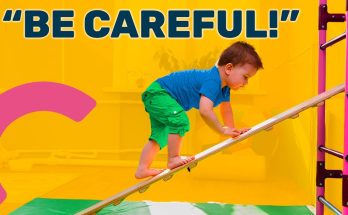Few things are as distressing for parents as a crying baby who won’t settle down. Whether it’s due to hunger, gas, overstimulation, or an unknown reason, a baby’s relentless cries can be overwhelming. Many parents try the usual soothing techniques—rocking, feeding, swaddling—but sometimes, nothing seems to work.
Fortunately, there are a few lesser-known techniques that can instantly calm a crying baby when traditional methods fail. These strategies are backed by experience, science, and the wisdom of seasoned parents. Let’s explore four powerful yet little-known techniques to soothe a fussy baby.
1. The “Reverse” Hold – Changing Their Perspective
One surprising reason babies cry is discomfort due to gas, digestion, or a simple need to change positions. Many parents instinctively cradle their baby in a traditional upright hold, but flipping them into a different position can work wonders.
How to Do It:
Try the “Reverse” or “Football” Hold:
- Lay the baby across your forearm, tummy-down, with their head resting near your elbow and your hand supporting their bottom.
- Gently tilt them slightly downward and apply a light pressure to their tummy with your arm.
- Rock them gently or walk around while holding them this way.
Why It Works:
- This position helps relieve gas or mild discomfort.
- The pressure on their belly can aid digestion.
- It provides a new perspective, which can distract and soothe a crying baby.
Many parents call this a “magic” hold because it often leads to immediate relief, especially for babies who struggle with colic or reflux.
2. The “Calm-Down Breath” Method
Babies are highly responsive to their caregivers’ emotions. If you’re feeling anxious or frustrated, your baby might sense it and become even more upset. One unique method to calm them down is to sync their breathing with yours using a slow, rhythmic technique.
How to Do It:
- Hold your baby close to your chest in a dimly lit, quiet space.
- Take deep, slow breaths—inhaling deeply through your nose and exhaling slowly through your mouth.
- Lightly pat or rub their back in time with your slow breathing.
- Whisper “shhh” or hum in sync with your breaths.
Why It Works:
- Babies naturally tune into their caregiver’s breathing patterns.
- Slow breathing regulates their nervous system, reducing stress.
- The rhythmic sound of your breath mimics the womb environment, which is deeply soothing.
This technique works especially well at bedtime or during moments of overstimulation when your baby seems too worked up to calm down.
3. The “Bathroom Sound” Trick
White noise is a well-known baby-calming tool, but some parents don’t realize just how powerful certain everyday sounds can be. The sound of running water, for example, is remarkably effective in calming babies almost instantly.
How to Do It:
- Take your baby into the bathroom and turn on the shower or sink faucet.
- Hold them close and gently sway or bounce while they listen to the water.
- If running water isn’t an option, play a recording of ocean waves or a running stream.
Why It Works:
- The sound of running water mimics the whooshing noises of the womb, providing a familiar sense of security.
- Water sounds create a natural white noise effect, blocking out other distractions.
- The gentle movement combined with the sound can create an almost hypnotic calming effect.
Some parents even find that placing a baby near a humidifier or dishwasher (supervised and safely distanced) can have a similar effect, as these sounds provide a steady, womb-like background noise.
4. The “Rhythmic Bottom Pat” Method
One of the most overlooked ways to calm a baby is a very specific rhythmic patting technique. Many parents instinctively pat their baby’s back while trying to burp them, but adjusting the rhythm and location of the pats can trigger an instant calming response.
How to Do It:
- Hold your baby in a slight upright position, either against your chest or in your lap.
- Use a firm but gentle patting motion on their bottom, rather than their back.
- Keep the rhythm slow and steady—like the sound of a heartbeat (a “bum-bum, bum-bum” pattern).
- Combine this with gentle rocking or swaying for an enhanced effect.
Why It Works:
- The rhythmic motion resembles the heartbeat sound from the womb, which is incredibly comforting.
- The bottom patting motion creates a calming vibration that can relax tense muscles.
- Babies who are overtired or overstimulated often respond well to repetitive, predictable movements.
Many parents report that this method is particularly effective in calming babies who are overtired and struggling to fall asleep.
Additional Tips for Calming a Crying Baby
If your baby is still upset, here are a few additional strategies that can complement these techniques:
– Try Skin-to-Skin Contact:
Holding your baby directly against your chest (skin-to-skin) can regulate their temperature, heart rate, and breathing, instantly soothing them.
– Offer a Pacifier:
Sucking is a natural reflex that helps babies self-soothe. Even if your baby isn’t hungry, a pacifier can work wonders.
– Use a Baby Carrier or Sling:
Being snugly held while you move mimics the sensations of being in the womb, often calming a fussy baby quickly.
– Check for Common Discomforts:
Ensure your baby isn’t too hot, too cold, or in need of a diaper change. Even small discomforts can lead to big cries!
Final Thoughts
Every baby is different, and what works for one may not work for another. However, these four little-known techniques—the Reverse Hold, Calm-Down Breath, Bathroom Sound Trick, and Rhythmic Bottom Pat—have helped countless parents calm their babies instantly when nothing else worked.
The key is to stay calm, be patient, and experiment with different soothing strategies. Over time, you’ll discover which techniques work best for your baby, creating a happier, more peaceful experience for both of you.
Next time your baby won’t stop crying, give one of these techniques a try—you might be surprised at how quickly they work!



